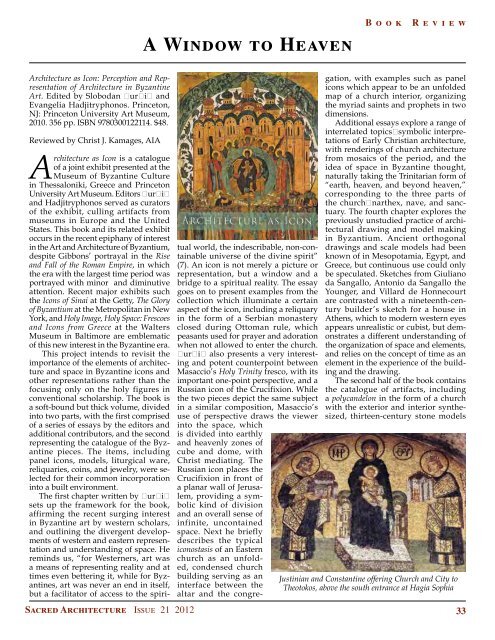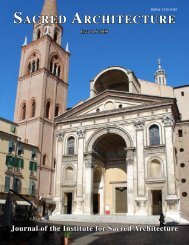Download Issue PDF - The Institute for Sacred Architecture
Download Issue PDF - The Institute for Sacred Architecture
Download Issue PDF - The Institute for Sacred Architecture
Create successful ePaper yourself
Turn your PDF publications into a flip-book with our unique Google optimized e-Paper software.
A Window to HeavenBook Review<strong>Architecture</strong> as Icon: Perception and Representationof <strong>Architecture</strong> in ByzantineArt. Edited by Slobodan Ćurčić andEvangelia Hadjitryphonos. Princeton,NJ: Princeton University Art Museum,2010. 356 pp. ISBN 9780300122114. $48.Reviewed by Christ J. Kamages, AIA<strong>Sacred</strong> <strong>Architecture</strong> <strong>Issue</strong> 21 2012<strong>Architecture</strong> as Icon is a catalogueof a joint exhibit presented at theMuseum of Byzantine Culturein <strong>The</strong>ssaloniki, Greece and PrincetonUniversity Art Museum. Editors Ćurčićand Hadjitryphonos served as curatorsof the exhibit, culling artifacts frommuseums in Europe and the UnitedStates. This book and its related exhibitoccurs in the recent epiphany of interestin the Art and <strong>Architecture</strong> of Byzantium,despite Gibbons’ portrayal in the Riseand Fall of the Roman Empire, in whichthe era with the largest time period wasportrayed with minor and diminutiveattention. Recent major exhibits suchthe Icons of Sinai at the Getty, <strong>The</strong> Gloryof Byzantium at the Metropolitan in NewYork, and Holy Image, Holy Space: Frescoesand Icons from Greece at the WaltersMuseum in Baltimore are emblematicof this new interest in the Byzantine era.This project intends to revisit theimportance of the elements of architectureand space in Byzantine icons andother representations rather than thefocusing only on the holy figures inconventional scholarship. <strong>The</strong> book isa soft-bound but thick volume, dividedinto two parts, with the first comprisedof a series of essays by the editors andadditional contributors, and the secondrepresenting the catalogue of the Byzantinepieces. <strong>The</strong> items, includingpanel icons, models, liturgical ware,reliquaries, coins, and jewelry, were selected<strong>for</strong> their common incorporationinto a built environment.<strong>The</strong> first chapter written by Ćurčićsets up the framework <strong>for</strong> the book,affirming the recent surging interestin Byzantine art by western scholars,and outlining the divergent developmentsof western and eastern representationand understanding of space. Hereminds us, “<strong>for</strong> Westerners, art wasa means of representing reality and attimes even bettering it, while <strong>for</strong> Byzantines,art was never an end in itself,but a facilitator of access to the spiritualworld, the indescribable, non-containableuniverse of the divine spirit”(7). An icon is not merely a picture orrepresentation, but a window and abridge to a spiritual reality. <strong>The</strong> essaygoes on to present examples from thecollection which illuminate a certainaspect of the icon, including a reliquaryin the <strong>for</strong>m of a Serbian monasteryclosed during Ottoman rule, whichpeasants used <strong>for</strong> prayer and adorationwhen not allowed to enter the church.Ćurčić also presents a very interestingand potent counterpoint betweenMasaccio’s Holy Trinity fresco, with itsimportant one-point perspective, and aRussian icon of the Crucifixion. Whilethe two pieces depict the same subjectin a similar composition, Masaccio’suse of perspective draws the viewerinto the space, whichis divided into earthlyand heavenly zones ofcube and dome, withChrist mediating. <strong>The</strong>Russian icon places theCrucifixion in front ofa planar wall of Jerusalem,providing a symbolickind of divisionand an overall sense ofinfinite, uncontainedspace. Next he brieflydescribes the typicaliconostasis of an Easternchurch as an unfolded,condensed churchbuilding serving as aninterface between thealtar and the congregation,with examples such as panelicons which appear to be an unfoldedmap of a church interior, organizingthe myriad saints and prophets in twodimensions.Additional essays explore a range ofinterrelated topics―symbolic interpretationsof Early Christian architecture,with renderings of church architecturefrom mosaics of the period, and theidea of space in Byzantine thought,naturally taking the Trinitarian <strong>for</strong>m of“earth, heaven, and beyond heaven,”corresponding to the three parts ofthe church―narthex, nave, and sanctuary.<strong>The</strong> fourth chapter explores thepreviously unstudied practice of architecturaldrawing and model makingin Byzantium. Ancient orthogonaldrawings and scale models had beenknown of in Mesopotamia, Egypt, andGreece, but continuous use could onlybe speculated. Sketches from Giulianoda Sangallo, Antonio da Sangallo theYounger, and Villard de Honnecourtare contrasted with a nineteenth-centurybuilder’s sketch <strong>for</strong> a house inAthens, which to modern western eyesappears unrealistic or cubist, but demonstratesa different understanding ofthe organization of space and elements,and relies on the concept of time as anelement in the experience of the buildingand the drawing.<strong>The</strong> second half of the book containsthe catalogue of artifacts, includinga polycandelon in the <strong>for</strong>m of a churchwith the exterior and interior synthesized,thirteen-century stone modelsJustinian and Constantine offering Church and City to<strong>The</strong>otokos, above the south entrance at Hagia Sophia33










